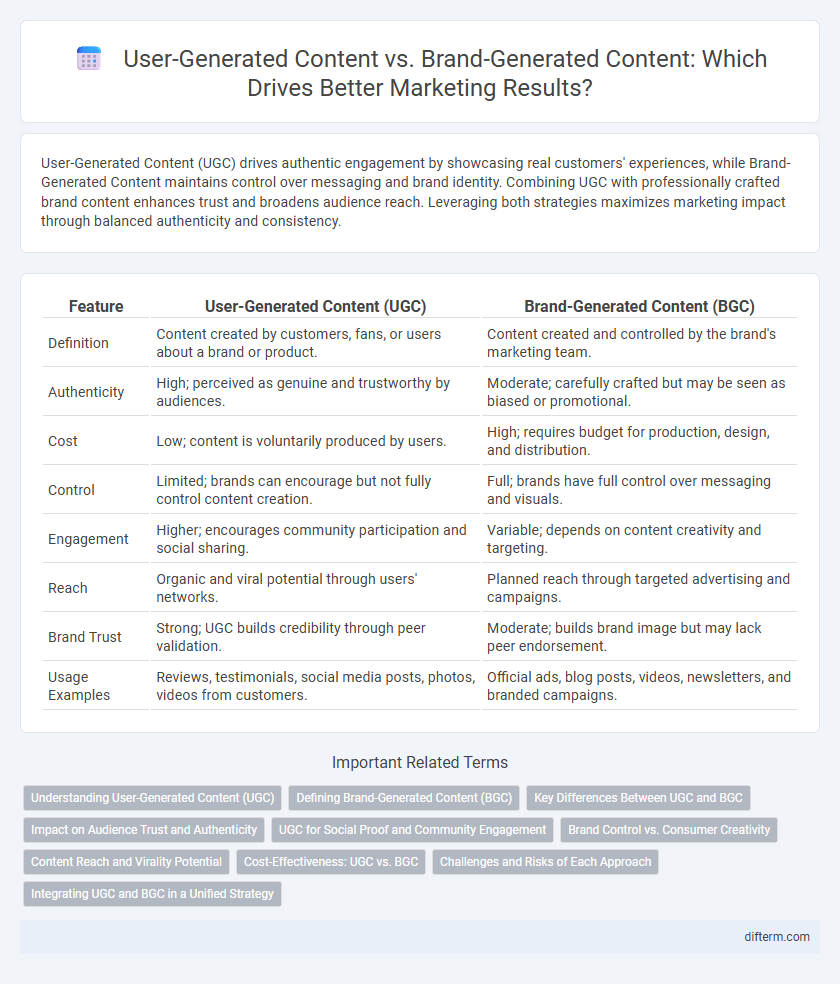User-Generated Content (UGC) drives authentic engagement by showcasing real customers' experiences, while Brand-Generated Content maintains control over messaging and brand identity. Combining UGC with professionally crafted brand content enhances trust and broadens audience reach. Leveraging both strategies maximizes marketing impact through balanced authenticity and consistency.
Table of Comparison
| Feature | User-Generated Content (UGC) | Brand-Generated Content (BGC) |
|---|---|---|
| Definition | Content created by customers, fans, or users about a brand or product. | Content created and controlled by the brand's marketing team. |
| Authenticity | High; perceived as genuine and trustworthy by audiences. | Moderate; carefully crafted but may be seen as biased or promotional. |
| Cost | Low; content is voluntarily produced by users. | High; requires budget for production, design, and distribution. |
| Control | Limited; brands can encourage but not fully control content creation. | Full; brands have full control over messaging and visuals. |
| Engagement | Higher; encourages community participation and social sharing. | Variable; depends on content creativity and targeting. |
| Reach | Organic and viral potential through users' networks. | Planned reach through targeted advertising and campaigns. |
| Brand Trust | Strong; UGC builds credibility through peer validation. | Moderate; builds brand image but may lack peer endorsement. |
| Usage Examples | Reviews, testimonials, social media posts, photos, videos from customers. | Official ads, blog posts, videos, newsletters, and branded campaigns. |
Understanding User-Generated Content (UGC)
User-Generated Content (UGC) encompasses any form of content--such as reviews, photos, videos, and social media posts--created and shared by consumers rather than brands. UGC enhances authenticity, builds community trust, and drives higher consumer engagement compared to traditional brand-generated content. Leveraging UGC effectively can increase organic reach and influence purchase decisions by showcasing real customer experiences.
Defining Brand-Generated Content (BGC)
Brand-Generated Content (BGC) refers to marketing materials created directly by a company, including blogs, videos, social media posts, and advertisements that consistently convey the brand's voice and values. BGC is strategically designed to shape brand perception, reinforce messaging, and drive customer engagement across owned digital channels. Emphasizing quality control and brand consistency, BGC serves as a foundation for building trust and establishing a recognizable brand identity.
Key Differences Between UGC and BGC
User-Generated Content (UGC) is created organically by customers, reflecting authentic experiences and fostering higher trust and engagement. Brand-Generated Content (BGC) is strategically produced by companies to control messaging and maintain brand consistency across marketing channels. UGC typically drives social proof and community building, while BGC emphasizes promotional goals and refined brand storytelling.
Impact on Audience Trust and Authenticity
User-generated content (UGC) significantly boosts audience trust by providing authentic, relatable experiences shared directly by consumers, enhancing brand credibility. Brand-generated content often appears polished yet can lack the genuine emotional connection that UGC delivers, making it less effective in fostering trust. Leveraging UGC strategically within marketing campaigns increases audience engagement and authenticity, driving stronger brand loyalty and conversion rates.
UGC for Social Proof and Community Engagement
User-generated content (UGC) significantly enhances social proof by showcasing authentic customer experiences and real-life brand interactions, which builds trust and credibility among potential buyers. Leveraging UGC fosters community engagement by encouraging customers to share their stories, photos, and reviews, creating a sense of belonging and active participation around the brand. Unlike brand-generated content, UGC offers relatable and diverse perspectives that increase user interaction and drive organic growth through word-of-mouth marketing.
Brand Control vs. Consumer Creativity
Brand-generated content offers marketers precise control over messaging, visual identity, and timing, ensuring consistent brand representation across all channels. User-generated content, driven by consumer creativity, provides authentic engagement and diverse perspectives that can enhance brand credibility and foster community trust. Balancing these approaches maximizes reach by combining strategic brand narratives with organic, relatable consumer contributions.
Content Reach and Virality Potential
User-generated content (UGC) typically achieves higher content reach and virality potential due to its authentic appeal and organic sharing among peer networks. Brand-generated content often lacks the same level of trust and relatability, limiting its ability to spread widely without significant paid promotion. Leveraging UGC not only amplifies brand visibility but also fosters stronger community engagement, driving exponential growth in content distribution.
Cost-Effectiveness: UGC vs. BGC
User-Generated Content (UGC) significantly reduces marketing expenses by leveraging authentic customer experiences without the high production costs associated with Brand-Generated Content (BGC). Studies show UGC campaigns can increase engagement rates by up to 28%, offering a cost-effective boost that traditional BGC often fails to deliver. Employing UGC strategically enables brands to maximize ROI while maintaining genuine consumer connections.
Challenges and Risks of Each Approach
User-Generated Content (UGC) presents challenges in maintaining consistent brand messaging and quality control, with risks including copyright infringement and negative or inappropriate posts that can damage brand reputation. Brand-Generated Content (BGC) allows for complete control over messaging and quality, but faces challenges in authenticity and audience engagement, often risking consumer skepticism and reduced trust. Balancing these approaches requires strategic monitoring, clear content guidelines, and active community management to mitigate risks and enhance marketing effectiveness.
Integrating UGC and BGC in a Unified Strategy
Integrating user-generated content (UGC) with brand-generated content (BGC) creates a cohesive marketing strategy that leverages authenticity and consistency to enhance consumer trust and engagement. UGC provides social proof and relatability, while BGC ensures brand messaging clarity and quality control, resulting in a balanced content mix that drives conversion rates. Employing analytics to monitor performance helps optimize content allocation across channels, maximizing reach and ROI.
User-Generated Content vs Brand-Generated Content Infographic

 difterm.com
difterm.com